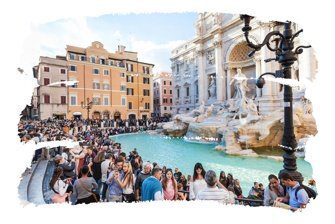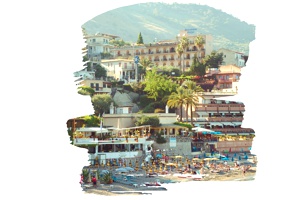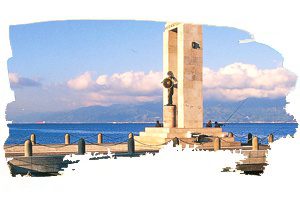Camogli and its gem called San Fruttuoso
Liguria is a delightful region and home to truly magical cities. Today we are going to an incredible place, close to the region’s capital, which is Genoa, and we are going to discover Camogli and its gem called San Fruttuoso. Are you ready? Let’s go! Here at Your Travel to Italy with Ana Patriciayou make the trip of your dreams!!! ALSO: see our “Accommodation in Italy – Tips for your holidays!”
Our introduction
The village of San Fruttuoso di Camogli is a real gem! San Fruttuoso is the perfect little town for those who like to walk, with natural beauty, and full of charm. Camogli and its gem called San Fruttuoso are cities that are part of Portofino Park, a beautiful natural gem in the Liguria region.
Walking among the beauties of the trails
To get from Camogli to San Fruttoso the best way, believe me: it’s walking! From Camogli, follow the trail to San Fruttuoso. The city can also be reached from other nearby locations such as San Rocco, Portofino or Santa Magherita Ligure.
It is good to know that the trails are different, and have different degrees of difficulty, but they are all very well signposted. Obviously, the choice of the ideal trail for you will depend on your physical preparation and your disposition, but I’m sure that your destination worths all the muscles worked to get there!
The classic trails to reach San Fruttuoso.
The trails that lead from Camogli to San Fruttuoso are diverse, however, some of them are the most famous. Also read: The most beautiful trails in Cinque Terre.
- Camogli > Pietre Strette > San Fruttuoso
Departing from Camogli, more precisely from Via San Bartolomeo, follow the steps to the center of San Rocco. From there, just follow the directions for Gaixella, and continue to San Fruttuoso. The route is about 5 km and is considered easy. The walking time is, on average, between 2 and 2 and a half hours, depending on who is doing the trail.
- San Rocco > Batterie > San Fruttuoso > Pietre Strette > San Rocco
San Rocco is a small village located just after Camogli. The path starts at the Church of San Rocco, passes close to a bar, the Bar Dai Muagetti. Walk to a place called Batterie (everything is well signposted, don’t worry!). This is where the remains of World War II bunkers are. Be sure to make strategic stops to have a drink and observe the panorama around you: it’s impressive!
Guys, it is not the most suitable trail for those who are afraid of heights or suffer from vertigo. Despite offering us beautiful landscapes, some rocks facing the sea can be uncomfortable because of their height, so follow this trail only if you don’t suffer from heights, ok?! On this trail, before reaching San Fruttuoso, you have to face a rather boring climb to finally reach the descent that will take you to San Fruttuoso beach and the Abbey. This is one of the more complicated trails, but it’s beautiful! The journey takes a little longer, reaching a 2h40 walk, but it’s up to you, of course! The path is 6 km long.
- Camogli > San Fruttuoso > Portofino
Perhaps the most classic among the classics! This is a favorite trail for tourists, as you can reach Portofino by following this path. The walk is very smooth and the path very easy! On this trail you will find some very interesting places such as the infamous Base 0, which is an old military post dating from the Second World War and, today, is a panoramic point that deserves a stop; then you can see Vessinaro where the charming cove of Cala degli Inglesi is located, and after so many beauties, reach the beautiful and elegant Portofino. Remembering that from San Fruttuoso to Portofino the journey takes about 1h45.
What to visit in Camogli?
First stop, of course: the small port of Camogli. Its colorful houses in the background set the tone of the city: cheerful, vibrant, and it seems to embrace us. The small port of Camogli opens up to the Basilica and is home to the various fishing boats as well as tourist boats, which come and go in constant motion.
TIP
- Be sure to walk to the lighthouse nearby! The view of Camogli and the sea air will make you speechless. The most beautiful moment? The sunset!
1 – The Basilica of Camogli
A must-see in Camogli is also the beautiful Basilica of Santa Maria Assunta, which is the city’s postcard. This basilica of impressive beauty: with a direct view of the sea, it stands on the famous Isola. Isola is a promontory that, in more remote times, “detached” itself from the continent.
This basilica was built in the 12th century and underwent multiple renovations. Its facade is neoclassical and fills our eyes with its beauty! In its interior we find several artistic works, in addition to a beautiful vault with frescoes by Barabino and Semino; the highlight is its marble and gilded stucco that make the internal structure a charm.
Cinque Terre Train Tour
How about an amazing train tour in Cinque Terre?
To learn more about it and book your tour: click here!
2 – The Dragon Castle
While in Camogli, be sure to visit Castel Dragone. Located right behind the Basilica of Santa Maria Assunta, the castle has a privileged position, on a huge rock, with a beautiful view of the sea and the city port.
With its typically medieval construction, the castle is a fortress built around the 12th century to combat the invasions of Saracen pirates from the Tyrrhenian Sea.
The Castle is also called Castello del Dragone, or Dragonara, and has also undergone several renovations. In 1500 it was deactivated as a fortress and turned into a prison.
In the 70s of the 20th century, it was the “home” of the Aquarium Tirreno, but it was permanently closed as soon as the “cousin” Aquarium of Genoa was opened and attracted many more visitors than it did.
The Castle is currently a civic-cultural center and is widely used by both locals and tourists as a center for activities, especially during the summer. From the top the view is breathtaking. Also read: 10 castles to visit in Italy.
3 – The giant pot and the Sailors Museum
A giant pot? Yes! Camogli has a giant pot! This pan is made of iron, weighs 1,100 kilograms, is 4 meters in diameter and has a 6 meter handle. It has a capacity of 3,000 liters of oil and 3 tons of fish; It became famous as it was shown on television in 1955 to celebrate the Camogli Fish Festival, which takes place every second Sunday in May and attracts visitors from all over the world.
The Sailors Museum is a charm! The museum is named after its founder, Ferrari, and tells the entire maritime history of the city. There you can see several models of ships, paintings, nautical instruments and objects that belonged to Giuseppe Garibaldi.
What to know in San Fruttoso?
Arriving at San Fruttuoso, it is impossible not to look away from the splendorous Abbey of the homonymous saint present there!
1 – The Abbey of San Fruttoso
With its typically Ligurian Romanesque architecture, the building is impressive! All made in white marble and slate from the valleys, you can see the Cloister, the Museum, the Doria tombs and the Tower in the church.
San Fruttuoso was a 3rd century Catalan bishop and saint, and his ashes are kept inside the Abbey. This church was founded in the 8th century AD. over the spring of a freshwater spring; later it was rebuilt in the 10th century as a Benedictine monastery. In the 13th century, the Abbey merged with the Doria family, who altered its plan, and erected the loggia with two rows of three-barred windows; after the work, the family decided to bring the family cemetery here and that was done. In 1983 the entire complex was donated to the FAI (Fondo per l’Ambiente Italiano), which manages it to this day.
2 – The Abbey Tower
Next to the Abbey, you can see the tower named after Andrea Doria built in 1562 for his heirs: Giovanni, Andrea and Pagano. The tower was initially intended to protect the village and its famous water source.
3 – The Christ of the Submerged Abyss
In front of the abbey there is a beach, some restaurants, and some fishermen’s houses. In the sea we can, in the center of the bay, find the Christ of the Abyss. Your hand is 10 meters deep, while to get to the base you have to go down to 15 meters deep into the sea. This statue was placed there in 1954. This work was commissioned by the diver Duilio Marcante who dedicated it to his friend Dario Gonzatti, who died while diving in 1947 in that area.
Good to know…
Camogli and San Fruttuoso are part of Portofino Park. To access maps, suggested itineraries, and other information, access the park’s official website by CLICKING HERE.
Watch this video and learn: What is the average cost of a day in Italy?
Subscribe to our channel and receive more videos with information and tips about Italy. Don’t forget to leave that Like;)
TRAVEL TO ROME!

“Your Travel to Rome” is the quintessential e-book for your travel to one of the finest tourist destinations on the planet!
LEARN MORE
Conclusion
Camogli and its gem called San Fruttuoso. Camogli and San Fruttuoso are, without a doubt, splendours in Liguria. Full of charm, they are cities that present themselves in an unpretentious way, but enchant.
If you feel insecure, have no time, and need help to organize your trip, don’t hesitate to contact me! I will love to help you make your dream trip to Italy come true. And how can I do that? Keep reading this post until the end and you will understand how we make your life and your trip much easier
Did my post help you? If so, be sure to post your comment below, but if you still have questions just send me a message I will answer you as soon as possible!
An Extra Help for your Trip
The best content from Your Travel to Italy!
Learn more about our tours in Italy right now!
- What to visit in Italy in 10 days?
- The ten must-see places in Tuscany?
- The best tips to save on your trip to Italy?
- What are the 10 most visited cities in southern Italy?
- Airports in Italy? How to get to your hotel? (Venice, Milan, Rome, Florence)
- What to do in 1/2/3/4 days in the main Italian cities?
- The best tips on food in Italy (wines, typical food, enogastronomy tours)
- How to get from Fiumicino Airport to Rome downtown?
- Your Travel to Italy: 10 tips for traveling through Italy!
Best regards from Italy



 PLACES TO STAY IN ITALY
PLACES TO STAY IN ITALY

 Save money!
Save money!